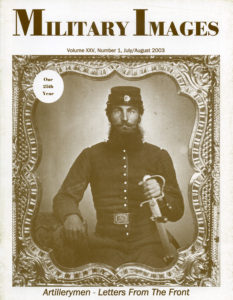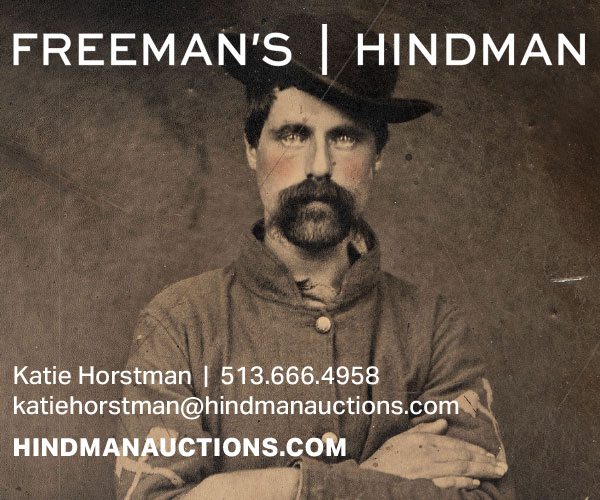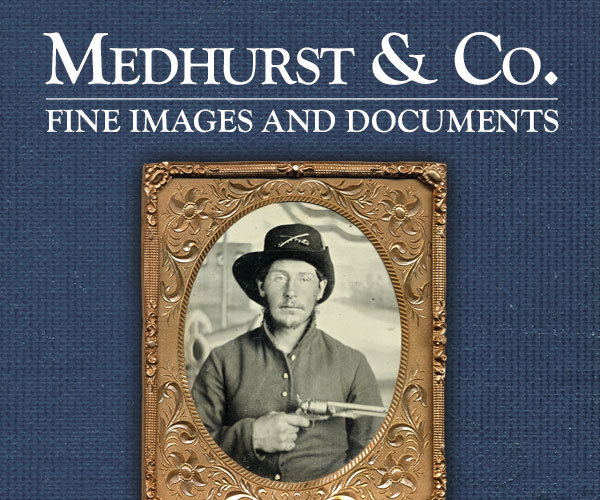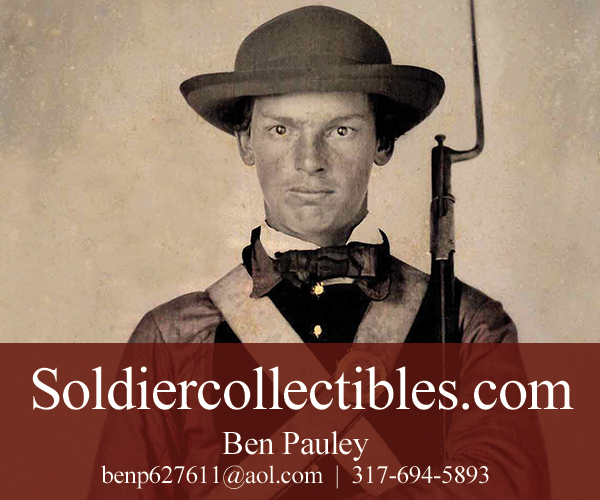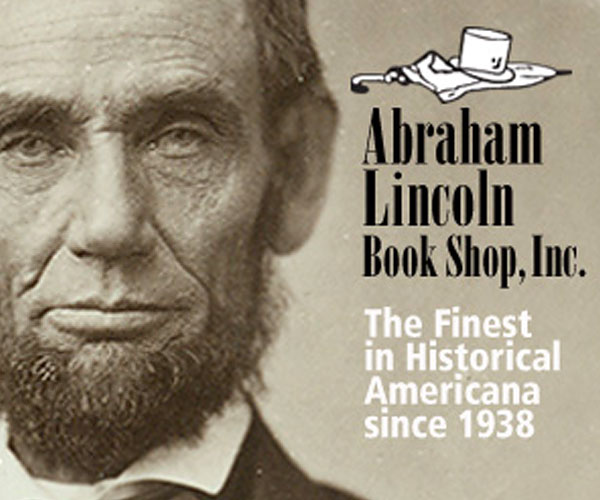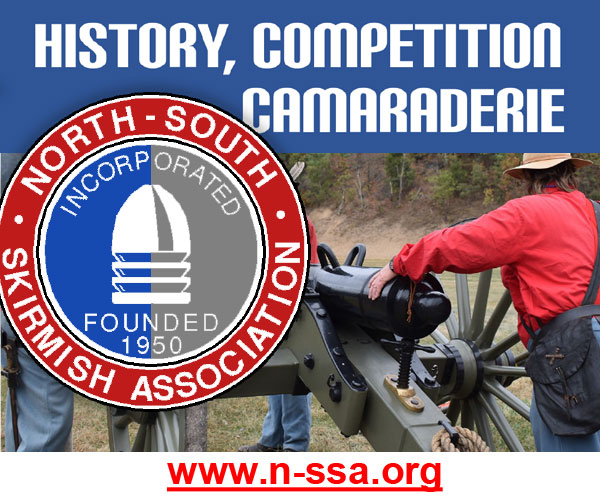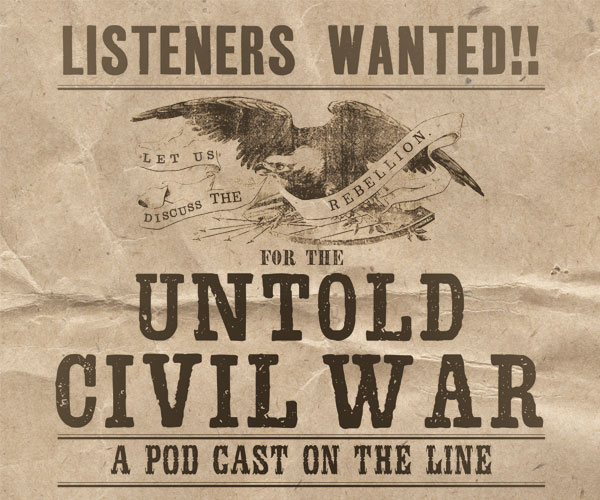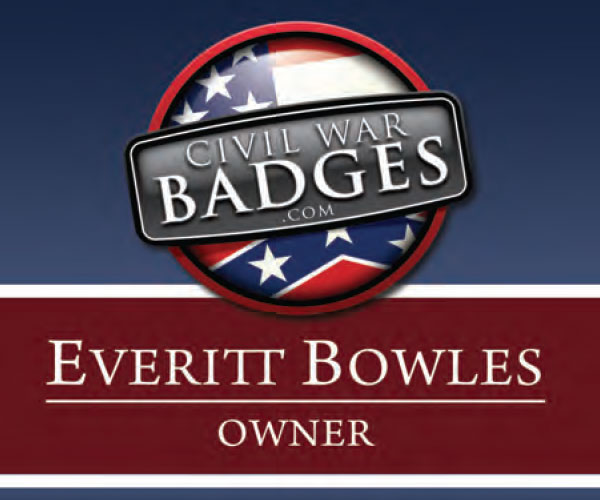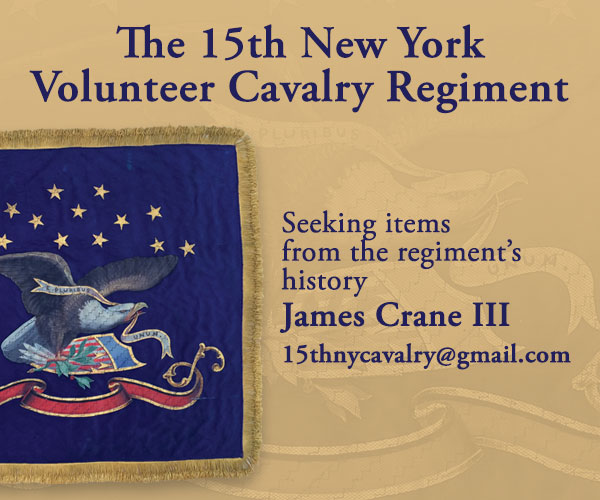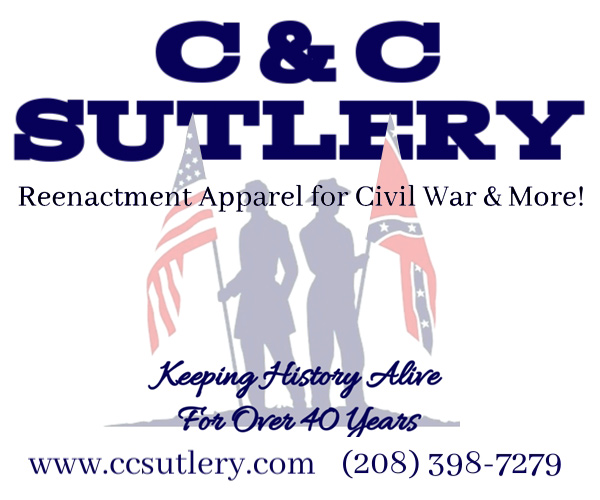The complete issue
Vol. XXV, No. 1
(40 pages)
Print edition: Visit our store to check availability
Digital edition: Visit JSTOR.org to purchase
Subscribe to MI
Explore the MI Archives: Browse | Advanced search | Tutorial
Inside
Cover image
An image from the Roy Mantle collection pictures a light artillery private with a rare militia saber.
Table of Contents (p. 1)
Mail Call (pp. 2-3)
Feedback includes two identifications of portraits from the last issue, and an announcement from the editor of the death of longtime collector Richard K. “Dick” Tibbals of Berwyn, Ill.
Passing in Review (p. 4)
Three publications are listed, including The Battle of Milroy Station (Tom Doherty Associates) by Robert H. Fowler, Commanding Voices of Blue and Gray (Tom Doherty Associates) edited by Brian M. Thomsen and “Damage Them All You Can:” Robert E. Lee’s Army of Northern Virginia (Tom Doherty Associates) by George Walsh.
The Auction Block (p. 6)
A sampling of sales from the popular auction site eBay is included.
A Photo Survey of Union Artillerymen (pp. 7-10)
A Confederate general, D.H. Hill, was quoted as saying that he could beat the world with Confederate infantry and Union artillery. This survey pays tribute to the blue gunners with 16 portrait photos, including the following identified men: Capt. Charles Griffin of the 5th U.S. Artillery, Lt. Adam J. Slemmer, commander of Fort Pickens in 1861, 1st lt. P.H. Child of the 1st U.S. Colored Artillery, John G. Mack of the 1st Ohio Light Artillery and Pvt. Alister M. Grant of Landis’ Pennsylvania Battery. Also featured is a group portrait of four members of Knap’s Independent (Pennsylvania) Battery: Lt. C. Tingley Jr., Capt. J.M. Knap, Lt. E.R. Geary and Lt. C.A. Atwell.
A Gray Cannoneer by Robert A. Williams (p. 11)
Pvt. Servetus McQueen Williams of the Surry Light Artillery, a Virginia unit. He served through the war and surrendered at Appomattox Court House in April 1865. He lived until 1918. Two images of Williams illustrate the text.
“Things Look Favorable:” Two letters from the 97th Pennsylvania at Petersburg (pp. 13-14)
Formed in Chester and Delaware counties in 1861, the regiment served largely on the Atlantic coast until called into the X Corps to serve outside Petersburg. Two letters provide a sense of the hardships endured in Virginia. One was written by regimental adjutant H.W. Carruthers and the other by Capt. Washington W. James. The etxt is illustrated with portraits of Col. Henry Ruhl Guss, 1st lt. James T. Skiles and an unidentified corporal.
“As Busy as Bees” by James Jerzorski (pp. 15-18)
Letters from William Courtney, the sergeant major of the 50th New York Engineers, provide a glimpse into a rarely seen part of the war. The narrative is illustrated with a sixth-plate tintype of Courtney as a private, the letterhead from one of his letters, a steroview of one of the observation balloons mentioned in a letter, a portrait of Pvt. David H. Cole and a stereoview of the May 1865 Grand Review in Washington, D.C.
“My Luck Is Due to Break Soon” (pp. 19-22)
A University of Washington student, 2nd Lt. Royall Wood “Roy” Mingins of the 364th U.S. Infantry, went off to war in 1918 and returned a battered hero. Numerous photographs, including multiple views of Mingins, illustrated the narrative. Also included are photos of several comrades: 1st Lt. Owen Summers, Capt. George W. Toland, 2nd Lt. James E. Fletcher and 1st Lt. James Hogan.
Bell’s Boys of Company B by Frederick C. Gaede (pp. 23-25)
Capt. Robert Bell’s Troop of Adams County Cavalry, Pennsylvania Volunteers, was raised in response to the invasion of Gen. Robert E. Lee’s Army of Northern Virginia into Pennsylvania in the summer of 1863. A brief history of the company is illustrated with a dozen portraits of its members: Capt. Robert Bell, 1st Lt. James Mickley, 2nd Lt. Henry G. Lott Jr., 1st Sgt. Hugh Paxton Bigham, 4th Sgt. Adam B. Black, 6th Corp. J. Harvy Cobean, and privates Walter Beamer, Rush McKean Bigham, J.B. Black, Wilson McCleary, Henry S. Myers and George W. Young.
The Work of Hamilton & Kellogg by Bill Lee (p. 26)
The Hamilton & Kellogg photograph gallery of San Francisco, Calif., is responsible for six portraits of unidentified Union officers pictured here.
“An Exceedingly Dangerous Man,” by Stewart Cruickshank (pp. 27-28)
Special Police Capt. Edwin Terrell was, according to the author, one of the Union’s most effective—and psychotic—guerrilla fighters. An account of his deeds and misdeeds is included here, illustrated with a wartime portrait of the subject. Also included is a photograph of pro-Southern guerrilla Bill Marion and an illustration of William Quantrill’s last fight, which occurred at Wakefield, Ky.
“I Can’t Give You My Colors” by Michael Dresse (pp. 29-31)
At the Battle of Gettysburg on July 2, 1863, a dramatic charge of the Pennsylvania Reserves through the Plum Run Valley just west of Little Round Top blunted the final thrust by Confederate attackers against the left flank of the Union army. At one point during the attack, the commander of the Reserves, Gen. Samuel W. Crawford, reached out to seize the colors to inspire the men. But the corporal who held the colors, George K. Swope, was reluctant to give them up. He finally did, but held on to Crawford/s trouser leg as the general rode on horseback up the rocky slope of the battlefield. This anecdote was disputed after the war. Recently discovered documents acquired by the author for his book, Never Desert Thee Old Flag! 50 Stories of Union Battle Flags and Color-Bearers at Gettysburg (Thomas Publications) sheds new light on the facts. The text is illustrated with photos of Crawford and a group shot that includes Corp. Swope and Corp. William Cake. The last soldier named claimed to be the reluctant color bearer. A third portrait of Corp. John Morton is also included.
Unraveling a Family’s Secrets by Stuart D. Brandes (pp. 32-34)
Abraham (Abram) Bevier, the eldest of four children born to Illinois farmers, joined the Union army in the summer of 1862. In the wake of his enrollment a tangled web of changing names for different enlistments and other unusual gaps complicated his story. The author connects the dots in this narrative, which includes portraits of Nathan Bevier, Maria Bevier and Sgt. Thomas J. Townsend of the 112th Illinois Infantry.
Uniforms & History by Michael J. McAfee (pp. 35-36)
In “What’s it all about…?” McAfee recounts his lifelong drive to paint military miniatures and wonders if, in the cosmic scheme of life, if it really matters. He goes on to point out a few examples of Civil War-era portraiture that might be confused with actual fighting men. Four portraits illustrate the text.
The Return of Cap’n Bob’s Caveat Emptorium by Harry Roach (p. 37)
The founding editor of MI reprises his role as the slick salesman who offers bogus deals to naïve collectors.
Sutler’s Row (pp. 38-39)
The Last Shot (p. 40)
An ambrotype from the collection of Roy Mantle pictures a militia second lieutenant cradling a non-regulation sword.
